
Anemone is a genus of flowering plants in the family Ranunculaceae, native to temperate zones. The genus is closely related to several other genera such as Pulsatilla (pasqueflowers) and Hepatica; some botanists include both of these genera within Anemone.
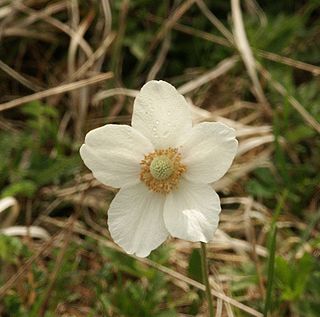
Anemonoides sylvestris, known as snowdrop anemone or snowdrop windflower, is a perennial plant flowering in spring, native to meadows and dry deciduous woodlands of central and western Europe and temperate Asia. It forms spreading patches, sometimes aggressively spreading.

Betula pendula, commonly known as silver birch, warty birch, European white birch, or East Asian white birch, is a species of tree in the family Betulaceae, native to Europe and parts of Asia, though in southern Europe, it is only found at higher altitudes. Its range extends into Siberia, China, and southwest Asia in the mountains of northern Turkey, the Caucasus, and northern Iran. It has been introduced into North America, where it is known as the European white birch, and is considered invasive in some states in the United States and parts of Canada. The tree can also be found in more temperate regions of Australia.

Hepatica is a genus of herbaceous perennials in the buttercup family, native to central and northern Europe, Asia and eastern North America. Some botanists include Hepatica within a wider interpretation of Anemone.

The genus Pulsatilla contains about 40 species of herbaceous perennials native to meadows and prairies of North America, Europe, and Asia. Derived from the Hebrew word for Passover, "pasakh", the common name pasque flower, refers to the Easter (Passover) flowering period, in the spring. Common names include pasque flower, wind flower, prairie crocus, Easter flower, and meadow anemone. Several species are valued ornamentals because of their finely-dissected leaves, solitary bell-shaped flowers, and plumed seed heads. The showy part of the flower consists of sepals, not petals.
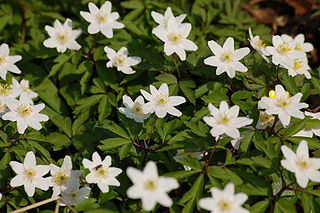
Anemonoides nemorosa, the wood anemone, is an early-spring flowering plant in the buttercup family Ranunculaceae, native to Europe. Other common names include windflower, thimbleweed, and smell fox, an allusion to the musky smell of the leaves. It is a perennial herbaceous plant growing 5–15 cm (2–6 in) tall.
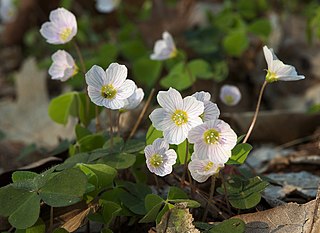
Oxalis acetosella, the wood sorrel or common wood sorrel, is a rhizomatous flowering plant in the family Oxalidaceae, common in most of Europe and parts of Asia. The specific epithet acetosella refers to its sour taste. The common name wood sorrel is often used for other plants in the genus Oxalis. In much of its range it is the only member of its genus and hence simply known as "the" wood sorrel. While common wood sorrel may be used to differentiate it from most other species of Oxalis, in North America, Oxalis montana is also called common wood sorrel. It is also known as Alleluia because it blossoms between Easter and Pentecost, when the Psalms which end with Hallelujah are sung.

Anemonoides ranunculoides, the yellow anemone, yellow wood anemone, or buttercup anemone, is a species of herbaceous perennial plant that grows in forests across Europe to western Asia, and less frequently in the Mediterranean region. It is occasionally found as a garden escape.
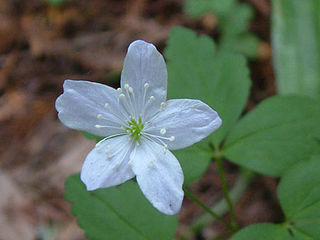
Anemonoides quinquefolia is a spring-flowering plant in the buttercup family, native to North America. It is commonly called wood anemone, not to be confused with Anemonoides nemorosa, a closely related European species.

Anemone hepatica, the common hepatica, liverwort, kidneywort, or pennywort, is a species of flowering plant in the buttercup family Ranunculaceae, native to woodland in temperate regions of the Northern Hemisphere. This herbaceous perennial grows from a rhizome.

Anemone cylindrica is an upright growing, clump forming herbaceous plant species in the genus Anemone and family Ranunculaceae. Plants grow 30–100 centimetres (12–39 in) tall, flowering early summer but often found flowering till late summer, the flowers are greenish-white. After flowering, the fruits are produced in a dense rounded columned spikes 20–35 millimetres (0.79–1.38 in) long. When the fruits, called achenes, are ripe they have gray-white colored, densely woolly styles, that allow them to blow away in the wind.

Anemonoides lancifolia, the lanceleaf anemone or mountain thimbleweed, is an herbaceous plant species in the family Ranunculaceae. Plants grow 20 to 30 cm tall, growing from a horizontally orientated rhizome, flowering mid spring to early summer. The flowers have white sepals that are 12–20 mm long. This species much resembles Anemonoides quinquefolia, of which it was formerly considered a subspecies, except that it is larger growing. After flowering fruits called achenes are formed in a small cluster, each achene is 3.5–5 mm long, lacks wings and has a straight or partly curved beak that is 1–1.5 mm long.

Anemonoides, formerly included within the genus Anemone, is a genus of flowering plants in the buttercup family, Ranunculaceae. As of August 2020, Kew's Plants of the World Online accepts 35 species and named hybrids in the genus Anemonoides:

Urticina crassicornis, commonly known as the mottled anemone, the painted anemone or the Christmas anemone, is a large and common intertidal and subtidal sea anemone. Its habitat includes a large portion of the coastal areas of the northern hemisphere, mainly polar regions, and it lives a solitary life for up to 80 years. Mottled anemones are similar to Dahlia anemones and both are commonly referred to as northern red anemones.

Enemion are spring ephemerals with white flowers, branching stems, and finely divided leaves in the buttercup family. One species, Enemion biternatum, is native to eastern and central North America, while Enemion occidentale, stipitatum, hallii, and savilei are native to the West Coast of the United States and Canada. The genus Isopyrum is similar, and has species native to Europe and Asia.

Anemonoides oregana is a species of flowering plant in the buttercup family known by the common names blue windflower, Oregon anemone, and western wood anemone. It is native to the forests of Washington, Oregon, and northern California in western North America, generally below 7,000 feet (2,100 m) elevation.
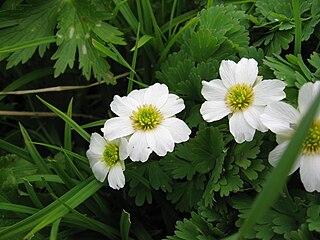
Callianthemum is a genus that consists of 24 species of little rhizomatous herbs from high mountains in Europe, Central Asia and East Asia. The botanical name comes from the Greek, which means beautiful flower. The plants are low-growing, ornamental perennials and are lovely to rock garden. Leaves are small and radical. Flowers are showy daisy-like, 1.5in in diameter, with 5-15 white or rose-color petals and nectaries at the base. Blooming in spring.

Anemonoides apennina, the Apennine anemone or blue anemone, is a rhizomatous perennial plant in the family Ranunculaceae. It is native to southern central Europe, taking its name from the Apennine Mountains, but widely naturalised elsewhere in Europe, including the United Kingdom. It can be confused with Anemonoides nemorosa which it resembles. It grows to 20 cm. In early spring it produces single blue flowers above ferny foliage, which dies down in summer. It is especially valued for its ability to colonise deciduous woodlands.
Blue anemone is a common name for closely related species of plants:
















